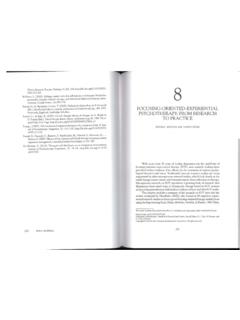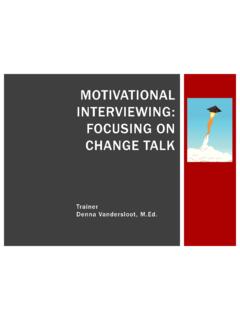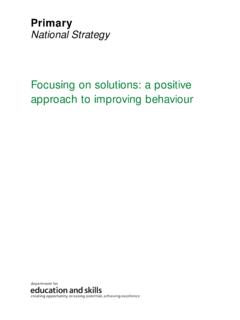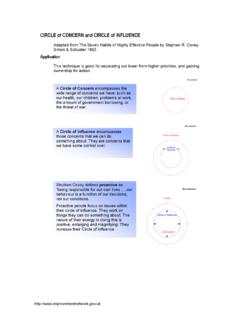Transcription of FOCUSING AND ART THERAPY
1 FOCUSING AND ART THERAPY : TOOLS FOR WORKING THROUGH POST-TRAUMATIC STRESS DISORDER. By Laury Rappaport, , ATR. FOCUSING Folio,. Vol. 17, No. 1, 1998. FOCUSING and art THERAPY are both tools and processes that can stand by themselves as helpful approaches to working with post-traumatic stress disorder. In this article, I will address how to combine FOCUSING with art THERAPY to help provide a safe container to hold and facilitate forward movement, or felt shift of the post-traumatic stress response. Because post-traumatic stress covers a wide range of experience, ( post-war, sexual abuse, therapist abuse, physical accidents, etc), I will focus this article on post-traumatic stress associated with child sexual abuse.
2 As Judith Herman states, The core experiences of psychological trauma are disempowerment and disconnection from others. Recovery, therefore, is based upon the empowerment of the survivor and the creation of new connections .. The first principle of recovery is the empowerment of the survivor. She must be the author of her own recovery." (1992, p. 133). FOCUSING offers a way of listening to the inner self, to the felt sense, that helps the client to be the author of her or his own recovery. Art THERAPY provides concrete expression of the FOCUSING process that serves as a visual guide and reminder of where to go on the journey of recovery. The art making provides a safe container to hold the felt experience; the art image serves to document the felt sense.
3 The action of FOCUSING with art THERAPY serves to help the experience to move forward, marked by the felt shift. I organize the process of FOCUSING and art THERAPY into Judith Herman's three stage model of recovery: establishing safety, remembrance and mourning, and reconnection with ordinary life. As Herman discusses, the stages do not necessarily unfold linearly. The work within the various stages can be used to correlate with Gendlin's steps in FOCUSING : clearing a space, felt sense, finding a handle, resonate, ask, and receive (Gendlin, 1988). Herman's stages help to understand the tasks of the therapist working with the various stages of healing through post -traumatic stress disorder.
4 First, I will address the aspects of FOCUSING that need to be considered at each of Herman's three stages. The next section deals with the application of art THERAPY with FOCUSING to the stages, followed by a case vignette and reflections of a therapist (survivor) who also works with survivors using FOCUSING and art THERAPY . FOCUSING RELATED TO HERMAN'S THREE STAGES OF HEALING. Stage I: Creating Safety I. The first step in working with clients who have post-traumatic stress disorder is to assess their level of safety to connect and look inside the body. Often with post-traumatic stress disorder, clients are overwhelmed by the feelings and experience of the traumatic memories, conscious or unconscious.
5 Since the experience is carried or held in the body, clients need to know that they can feel safe connecting with the body. 1. 2. It is important that clients have the permission and acceptance to keep eyes open during the FOCUSING process if they choose to. Often, particularly clients with sexual abuse need to be able to see what is happening around themselves in order to feel safe. Many clients experience a hyper vigilance of watching in order to feel safe. 3. While it is understood in the FOCUSING process that the focuser (client) is in charge of the experience, it is critical for survivors of sexual abuse to know they are in charge of their experience.
6 It is important for the client to know she or he decides whether it is safe to look within, and for how long. Stage II: Remembrance and Mourning (Working through the Trauma). I. Once the client feels safe to connect with the body, to notice and listen to the felt sense inside, the client may be ready to begin working through the traumatic experience. This phase involves awareness of the traumatic experience(s), expression, verbally or non verbally about the experience, exploration of the effects on current level of functioning, and gentle guiding into the felt sense of the experience. Stage III: Reconnection with Ordinary Life I. This stage of healing is characterized by helping the client to do the things in life, or create the life, that she or he truly wants.
7 FOCUSING is on the forward movement of the client's life. This stage is characterized by asking and receiving from the felt sense. APPLICATION OF FOCUSING AND ART THERAPY TO HERMAN'S THREE STAGES OF HEALING. Stage I: Creating Safety Using FOCUSING and Art THERAPY Clearing A Space may be used during this phase of healing. Possible ways of facilitating clearing a space using FOCUSING and art THERAPY : I. Safe Space: Imagine a place of safety. It may be one that you already know, or it may me one that you can create in your imagination. Describe that place to your .the images, the colors, the sounds or silences, the temperature, the whole feel of it.
8 Once you describe it to yourself, begin to sense the whole feel of that safety inside your body .. What is the whole feel of the safety within your body? See if there is an image, or word or phrase to describe that place. Using art materials (markers, craypas, paper, magazine pictures, etc.) create an image of the felt sense of the safe place. Once the client does this step, it may be fine to just stop here. This is an important step in creating a safe place within that the client can always choose to return to, whenever she or he needs to. 2. Safe Space/Creating Distance: Once the client creates the safe space, and can clearly make connection to it when she or he needs to, then the client can move to place all the things between her/him and feeling all fine.
9 Beginning with the safe place, in the art form, the client uses the art materials to symbolize the issues in the way of feeling all fine. Possibilities include, drawing symbols of each issue, or writing, onto pieces of construction paper; tearing or cutting into shapes papers to represent each issue; or using clay, beads, or other objects to symbolize the issues. 2. These objects or papers are then placed at a distance that feels right to the client, from the safe place. The client resonates, or checks inside for a feeling of rightness as well as to check whether there is some more space inside. 3. The Protector: Another art THERAPY tool to help facilitate safety, is for survivors of sexual abuse to invite the image or presence of a protector, based on a real person or protector in their life, or imagined.
10 Describe the image of that protector to yourself. Sense what that feels like inside your body .. What is the 'whole feel of it? See if there is an image that matches or acts like a handle for the protector.. When you're ready, draw/create an image that matches, or acts like a handle for that protector. If the client connects with the image/art piece, it may be helpful to have the drawing/image present during subsequent sessions. Stage II: Remembrance and Mourning (Working Through the Trauma) Using FOCUSING and Art THERAPY Listening to the felt sense, finding the handle, and resonating are used during this stage of healing. The client chooses what to focus on-which may be after clearing a space and choosing an issue, or it may be interwoven into the unfolding therapeutic process ( the client is talking and the therapist suggests checking inside).








